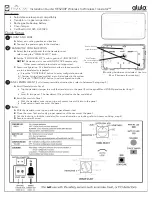
Program P4: String 4-5: String Main
249
As a rule of thumb, harmonics which are multiples of
the denominator will be silent. For instance, if the
Position
is set to 20.0, the ratio is 1/5, and so every
fifth harmonic will be silent: 5, 10, 15, etc. This is like a
comb filter, with successive, evenly-spaced notches.
The graphic below shows the shape of this comb filter,
and the resulting basic harmonic structure. (Comb
filters are named because their shape looks a little like
the teeth of a comb.)
Harmonic structure with Position = 20.0 (ratio = 1/5)
The table below shows a few more settings which
cancel out specific harmonics:
Effect of Excitation Position on harmonic structure
You can also adjust the positions of the two Pickups,
which produce similar comb filtering effects. (For more
information, see “4-8a: Pickup 1” on page 256.) The
filtering produced by the excitation position and the
two pickups is cumulative, and can produce complex
patterns of peaks and valleys in the overall frequency
response.
AMS
[List of AMS Sources]
This selects a modulation source to control the
Position
. Modulation is applied only at note-on; while
the note is sounding, changing the modulation has no
effect. For a list of AMS sources, see “AMS (Alternate
Modulation Source) List” on page 967.
Intensity
[-100.0…+100.0]
This controls the depth and direction of the
Position
modulation.
Tracking Mode
[String Track, Keyboard]
This controls the relationship between the pickup
Position
and the pitch.
String Track
scales the position according to the
current String, as set in the String Track section.
Keyboard
scales the position according to pitch,
without taking the String settings into account. This
might be more appropriate for clav sounds, for
instance.
Tone
[-100…+100]
This controls the affect of the
Position
on the overall
tone. When
Tone
is set to 0,
Position
has no effect.
–100
is generally the most realistic, although other
settings may give good results depending on the
particular excitation signal.
–100
also works well to
counteract the low-end “thump” which can be caused
by low-frequency excitation signals, including plucks
with very low (or negative)
Width
values.
Other
Tone
settings will make the comb filter
described under
Position
, above, work differently.
Settings between –100 and 0 will reduce the effect of
the filter, until–at 0–it has no effect at all. Positive
settings will make the filter work in reverse,
reinforcing harmonics instead of eliminating them.
What does Tone do?
When you pluck a real string, the string vibrates
outward in both directions from the excitation
position. These two vibrations bounce off their
respective ends of the string, return in the opposite
direction, and interact with each other along the way,
affecting the timbre of the string.
In the real world, this can’t be changed–but the Tone
parameter lets you bend the physics a bit. This is
useful, in part, because some of the things you can use
to “pluck” the string–such as a PCM sample–aren’t
things you could use in the real world, either. The Tone
parameter gives you another tool adjust the way that
these unusual excitations affect the timbre.
Put simply, Tone lets you pluck the same string twice,
in the same place, with the waves from each pluck
moving in only one direction. One of these plucks–
think of it as the one that moves the wave “forward”–
always works in the physical way. Tone controls the
pluck that moves the wave “backwards.”
“Plucking” the string with different Tone settings
4-5b: Harmonic
This models pressing down lightly (or firmly) in the
middle of the string, like playing harmonics on a
guitar.
Position
Ratio of string
length
Effect
50.0
1/2
Odd harmonics are silent,
like a square-wave.
33.3
1/3
Every third harmonic is
silent: 3, 6, 9 etc.
25.0
1/4
Every fourth harmonic is
silent: 4, 8, 12 etc.
20.0
1/5
Every fifth harmonic is
silent: 5, 10, 15 etc.
1
Harmonics:
Shape of comb filter:
Volume
2
3
4
5
Silent Harmonics:
6 7 8 9
10
15
Excitation Position
Wave
Wave
Tone = -100
Tone = 0
Tone = +100
String
Содержание Electronic Keyboard
Страница 1: ...Parameter Guide Parameter Guide ...
Страница 2: ......
Страница 180: ...Program mode EXi 170 ...
Страница 290: ...EXi STR 1 Plucked String 280 ...
Страница 572: ...Sequencer mode 562 ...
Страница 700: ...Global mode 690 ...
Страница 751: ...Insert Effects IFX1 IFX12 Routing 741 Fig 2 3a Fig 2 3b ...
Страница 902: ...Effect Guide 892 ...
















































